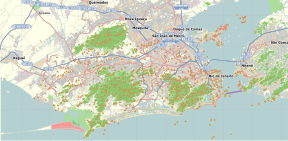Vila Operária da Gamboa
| Vila Operária da Gamboa | |
|---|---|
 Vila Operária Gamboa Vila Operária Gambôa in Rio de Janeiro | |
| Alternative names | Vila Gamboa |
| General information | |
| Status | Complete |
| Architectural style | Modernist |
| Address | Rua Barão da Gamboa 158-160, Santo Cristo |
| Town or city | Rio de Janeiro |
| Country | Brazil |
| Coordinates | 22°54′02″S 43°11′56″W / 22.900597°S 43.198978°W |
| Construction started | 1931 |
| Opened | 1933 |
| Height | |
| Architectural | Modernist |
| Technical details | |
| Floor count | 2 |
| Design and construction | |
| Architect | Lúcio Costa, Gregori Warchavchik |
| Other information | |
| Number of rooms | 14 |
Vila Operária da Gamboa (English: Workers' Village of Gamboa) is an apartment building in Rio de Janeiro, Brazil. It is located in the Santo Cristo neighborhood near the Gamboa waterfront area of the city. It was designed by Lúcio Costa (1902-1998) in 1931 during his three-year partnership with Gregori Warchavchik, and completed in 1933. The goal of modernists in Brazil was to build for the working class, and Vila Operária Gamboa is the first modernist building constructed for the poor in Brazil.[1][2][3][4]
Vila Operária da Gamboa was built on a narrow, irregular parcel of land. It is located on the north side of Rua Barão da Gamboa at the intersection of Rua Cardoso Marinho on land ceded to the project by Dr. Fábio Carneiro de Mendoça. The technology for modern construction was at an early stage in Brazil and workers in Rio de Janeiro lacked the technical skills to work with concrete, steel, and stone. Warchavchik brought workers from his modernist projects in São Paulo to complete the building.[1][4]
The structure consists of fourteen units on two floor. Twelve were full apartments of 30 square metres (320 sq ft) with a living room and two bedrooms. Two were simple studio apartments of 10 square metres (110 sq ft), and were meant to serve as homes for the "concierges" or janitors of the building. The façade of the building was painted in vivid green and tan with the walkway banister painted in white.[1][4] In its style it resembles early 20th-century residences of Louis Bourgeois and Cliff May.[2]
Vila Operária da Gamboa remains standing but is in a state of advanced dilapidation. It is a listed building of the City of Rio de Janeiro (Bens Tombados No Município Do Rio De Janeiro), designated as such in 1986.[1][5]
References[]
- ^ a b c d Cavalcanti, Lauro (2003). When Brazil Was Modern: Guide to Architecture, 1928-1960. New York: Princeton Architectural Press. pp. 122–124. ISBN 1568983417.
- ^ a b Guia da arquitetura moderna no Rio de Janeiro (in Portuguese). Rio de Janeiro, Brazil: O Centro Casa da Palavra. 2010. p. 49.
- ^ Lino, Sulamita Fonseca (2009). "O modernismo "com sabor local": uma arquitetura antropofágica?". Cadernos de Arquitetura e Urbanismo. 12 (3): 133–152. Retrieved 2016-08-22.
- ^ a b c Meira, Ricardo Reis (2013). Frente ou Fundo?: A inserção da casa unifamiliar na escala residencial do Plano Piloto de Brasília (PDF) (in Portuguese). Brasilia: Universidade De Brasília Faculdade de Arquitetura e Urbanismo FAU/UNB. pp. 44–46. Retrieved 2016-08-21.
- ^ "Determina o tombamento dos bens arquitetônicos que menciona". Decreto, Prefeito da Cidade do Rio de Janeiro No. 6.057 of 23 August 1986 (PDF) (in Portuguese). Retrieved 2016-08-21.
- Apartment buildings
- Lúcio Costa buildings
- Buildings and structures completed in 1933
- Modernist architecture in Brazil
- 1933 establishments in Brazil
- Brazilian building and structure stubs
